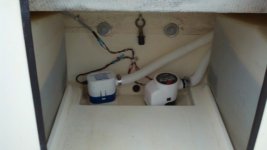I finally swapped out the failing Rule 1100 for a Johnson 1250. It's a bit bigger, but a really nice pump. It comes with interchangeable 1-1/4" and 1-1/8" barbed outputs, as well as an integrated one way valve (just a rubber flapper backed by a stainless washer.
Since I'm installing this along with an unrestricted (no one-way) backup pump, I'm choosing to use a one-way on this primary pump. If I didn't, the amount of water in the outlet hose, including the loop above the through hull, that drains back into the bilge when the pump turns off, is almost enough to turn the pump on again, and with any rain, the pump would run a lot more than necessary.
The pump seems better built than the Rule 1100, and the switch seems far more durable than a float switch or a probe sensor. This one detects the presence of water through the body of the pump. There are 2 sensors, a high and low (one at 2-1/2" and one at 3/4"). When both sensors detect water it turns on. When the low sensor no longer senses water, it turns off. To test the pump you place fingers over both sensors (they're marked on the case), and it will come on. I got the pump for $73 from Amazon.
I wanted this pump to be the primary, so I needed to remove the Rule basket that was attached to the bilge area in a bed of epoxy. Fortunately with a little twisting and prying, the basket came off with the whole chunk of epoxy. It did pull up a tiny piece of gelcoat, exposing black fiberglass, so I'm not sure I'd recommend this technique. I'd probably break the basket and use a chisel to take the epoxy off in chunks.
To attach the new basket, I decided to use some left over 3M 4000. I drilled extra holes in the bottom of the new pump basket, then applied 4000 to it and squished it down against the floor (I also sealed the little hole in the gelcoat with 4000. After curing for 8 hours, it was really on there, and I could install the new pump.
One other thing I've been meaning to mention, I hung a spare drain plug in the bilge from a cable clamp with a slit cut in it. That way if I ever do something dumb like back the boat down a ramp without a plug, there's one right there that I can shove in from the inside.



